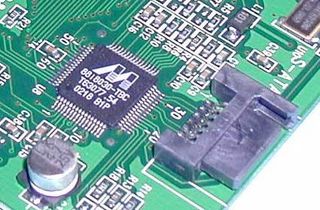Western Digital Breaks a Record: WD2000JB with 200 GB
Seagate
The Barracuda ATA V is raring to go. Up to 120 GB will be offered - is this supposed to stand up to the immense capacities offered by Maxtor and Western Digital?? In the area of SCSI, at least with the Barracuda 180 , the lead is in good hands - and this has been the case for more than one year!
Technically, Seagate is still at the very front, because the Barracuda ATA V runs at 7200 rpm and has 60 GB per platter. Moreover, the drive will be available in a Serial-ATA version right from the beginning.
| Seagate Barracuda ATA V | |
|---|---|
| Capacities | 40, 60, 80, 120 GB - UltraATA/10060, 80 GB - Serial ATA |
| Data Density | 60 GB per platter |
| Seek Time | 9 ms (SATA), 9.3 ms (UltraATA/100) |
| Rotation Speed | 7200 rpm |
| Cache | 2 MB (estimated) |
Decisions, Decisions: Interfaces

UltraATA (left) vs. Serial ATA. The new cable is virtually immune to kinking, is reasonably priced and works despite the heat that builds up in the PC. Reverse polarity is impossible.
Basically, it's all called IDE (Integrated Drive Electronics), but each manufacturer has a different interpretation of it. Serial ATA is still far from achieving a real breakthrough, even though many motherboard manufacturers are integrating Serial-ATA controllers. Another popular feature are Serial-ATA bridges, for using conventional ATA controllers with Serial-ATA drives. However, the trend veers from the latter method, even though this makes it much easier to switch over to the interface of the future.
Western Digital has not announced a [Serial-ATA] drive, and the Serial-ATA models from Seagate and Maxtor have yet to become available, so the motherboard manufacturers could, in fact, reduce the integration of Serial-ATA components - currently, hardly anyone can make use of the corresponding controller. It's a similar situation with FireWire controllers - positive reponse is too low, and the costs are too high.

With the help of Serial-ATA bridges (chip pictured above), Serial ATA drives can be run using conventional IDE and ATA controllers. Small adapters are also possible with these bridges.
Maxtor, the champion of UltraATA/133, will be equipping all new drives with this feature. By contrast, IBM, Seagate and Western Digital will be equipping their ATA drives in the next few years with only UltraATA/100 until they've completed the switch over to Serial ATA. However, in practice, even this latest generation won't be able to reach the bandwidth limit of approximately 85 MB/s. Conclusion: UltraATA/100 is sufficient!
Stay on the Cutting Edge
Join the experts who read Tom's Hardware for the inside track on enthusiast PC tech news — and have for over 25 years. We'll send breaking news and in-depth reviews of CPUs, GPUs, AI, maker hardware and more straight to your inbox.
A further argument for UltraATA/100 is the PCI bus, which, according to the current specification, can only transport 133 MB/s at 33 MHz anyway. And don't forget that this bandwidth has to be shared by all PCI devices (e.g., sound system, network controller, USB controller, etc.). In this context, it doesn't make sense to use Serial ATA from a performance point of view - as a matter of fact, PCI would put the brakes on the theoretically possible 150 MB/s. The only thing that one could hope for is that Serial ATA will quickly be introduced to chipsets and that PCIX will arrive soon.
Most Popular

